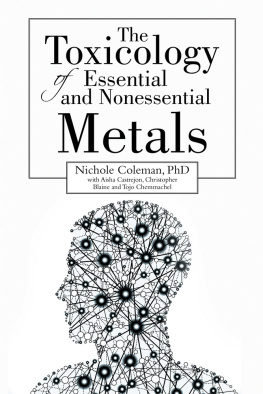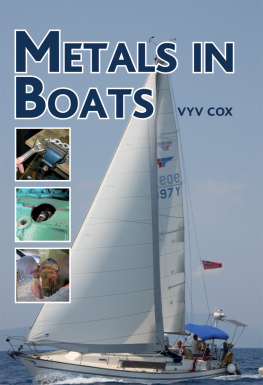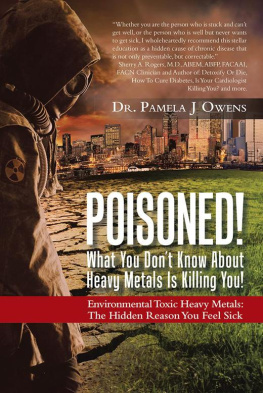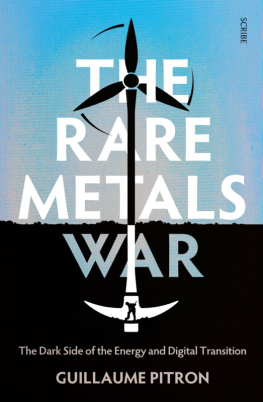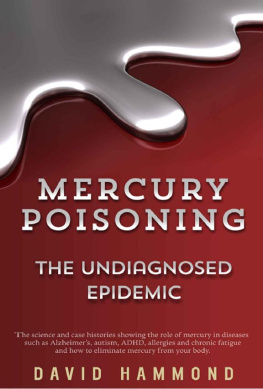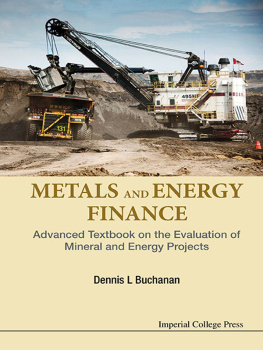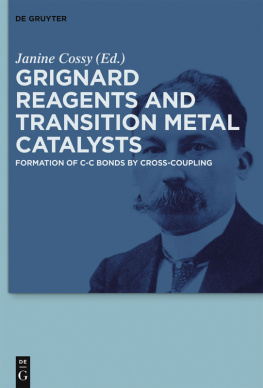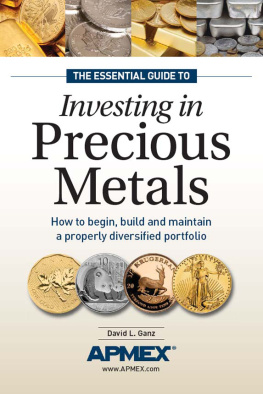The
Toxicology
of
Essential
and
Nonessential Metals
Nichole Coleman, PhD
Copyright 2017 Nichole Coleman, PhD.
All rights reserved. No part of this book may be reproduced, stored, or transmitted by any meanswhether auditory, graphic, mechanical, or electronicwithout written permission of the author, except in the case of brief excerpts used in critical articles and reviews. Unauthorized reproduction of any part of this work is illegal and is punishable by law.
This book is a work of non-fiction. Unless otherwise noted, the author and the publisher make no explicit guarantees as to the accuracy of the information contained in this book and in some cases, names of people and places have been altered to protect their privacy.
ISBN: 978-1-4834-6908-9 (sc)
ISBN: 978-1-4834-6907-2 (e)
Library of Congress Control Number: 2017906279
Because of the dynamic nature of the Internet, any web addresses or links contained in this book may have changed since publication and may no longer be valid. The views expressed in this work are solely those of the author and do not necessarily reflect the views of the publisher, and the publisher hereby disclaims any responsibility for them.
Any people depicted in stock imagery provided by Thinkstock are models, and such images are being used for illustrative purposes only.
Certain stock imagery Thinkstock.
Lulu Publishing Services rev. date: 5/4/2017
Contributing Authors
Nichole Coleman, PhD
San Francisco State University
San Francisco, California
Chemistry
Christopher Bl aine
University of CaliforniaDavis
Davis, California
Neurobiology, Physiology, and Behavior
Christopher Bi vins
San Francisco State University
San Francisco, California
Botany
Bhumil P atel
UCSanta Cruz
Santa Cruz, California
Molecular, Cellular, and Developmental Biology
Christopher Bl aine
University of CaliforniaDavis
Davis, California
Biology
Emmanuel Ro mero
San Francisco State University
San Francisco, California
Biology
Paul Valencia Scatt olin
California State UniversityEast Bay
Hayward, California
Biological Sciences
Alexandria Luf ting
San Francisco State University
San Francisco, California
Biology
Contributing Authors
Aisha Castr ejon
Sacramento State University
Sacramento, California
Biology
Lyia Yang, PhD
University of CaliforniaDavis
Davis, California
Plant Biology
Harold Ga lvez
University of CaliforniaBerkeley
Berkeley, California
Microbial Biology
John M ateo
San Francisco State University
San Francisco, California
Microbiology
Brittany de Lara
University of CaliforniaIrvine
Irvine, California
Biological Sciences
Hazel T. Sal unga
San Diego State University
San Diego, California
Biology
Tojo Chemma chel
San Francisco State University
San Francisco, California
Kinesiology
Kathry n Ma
University of CaliforniaSanta Cruz
Santa Cruz, California
Evolution and Ecology
Contributing Authors
Meryl De La Cruz
University of the Pacific
Stockton, California
Biochemistry
Henry Chen
University of CaliforniaBerkeley
Berkeley, California
Public Health
Hayley M oore
University of CaliforniaBerkeley
Berkeley, California
Political Economics
April Hishi numa
University of CaliforniaBerkeley
Berkeley, California
Cognitive Science
Chia -I n Jane Lin
University of CaliforniaSanta Barbara
Santa Barbara, California
Biology
Christopher T aing
University of the Pacific
Stockton, California
Biological Science
Contents
Nichole Coleman PhD, Chia-In Jane Lin and Christopher Taing
What does the poison of kings have to do with the theatrical play Arsenic and Old Lace ? The play, written by Joseph Kesselring, was inspired by a true story of Amy Archer-Gilligan, a woman whod killed anywhere from twenty to one hundred people with arsenic-tainted food and drink. With her second husband, Archer-Gilligan owned a nursing home called the Archer Home for Aged People. She was suspected of killing both of her husbands and many residents in the nursing home. Police found large quantities of arsenic, which Archer-Gilligan said was used to kill the undesired rodent residents of the home. She was put on trial and found guilty, yet she pleaded a case of insanity and was granted a life sentence. In prison, she was eventually admitted into a mental hospital, where she remained until her death.
The blades we use, the pots and pans we cook with, face paint and childrens makeup contain numerous toxic metals. In make-up alone, there is as many as four types of metals. Costume paint contains cadmium and lead. Most paints that contained toxic metals are found in dark pigmented paints. Sadly, cosmetics are the least regulated consumer product on the market, and these toxic ingredients dont have to be labeled on the products.
All toxic substances are harmful to human health, but metals are different from other synthetic toxicants because they can be neither created nor destroyed, and thus they are nonbiodegradable. Today, toxic heavy metals are found in cigarettes and gourmet foods such as fish, chocolate, and food seasonings. Irrespective of how carefully metals are used in industrial processes, some level of human exposure is unavoidable. This indestructibility coupled with the toxic bioaccumulation contributes to the high concern for metals in our environment.
In this book, we feature twenty-one chapters on various aspects and characteristics of metal dependency (metals that are essential for human health) and toxicity (metals that are nonessential for human health). The chapters review a mixture of original research articles, perspectives, and reviews of Internet sources that underscore the dangers of some consumer products. Each chapter deals with the environmental exposure, clinical presentation, and occupational exposures to a variety of different metals, including cobalt, copper, iron, arsenic, cadmium, zinc, and platinum, to name a few. We also devote an entire section to essential metals that can be a potential danger if taken without care. The authors also discuss a number of different types of toxicity, including contact dermatitis, neurotoxicity, and chemical carcinogenesis. The overall focus of this book is to bring awareness to the exposures of metal toxicity and to make the reader aware of some medical advances of potential toxic heavy metals.
The conclusion of each chapter underscores the fact that metal toxicity is a complex problem and that we have much more to learn about the epidemiology, exposures, dose-response relationships, mechanisms of toxicity, and occupational factors altering human sensitivity to metal toxins. At the end of each chapter, the bibliography list all of the sources for which the chapters were written. Although you will need to have experience with basic chemistry and biology to understand the process by which these metals can affect your physiology, it is our sincerest hope that this compilation of metal toxicological studies will not only introduce and familiarize the reader to the topic herein but also serve as a useful and valuable reference for those who are not familiar with the studies in metal toxicology. We also hope that it will serve as a provocation to those in the field, as well as others, to develop, produce, and generate new methodologies to investigate the mechanisms by which metals serve as toxicants and to develop approaches that can be used to protect against their toxicities.
Next page
